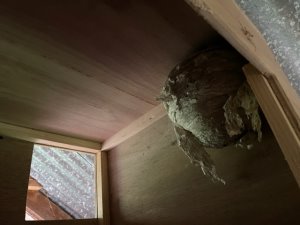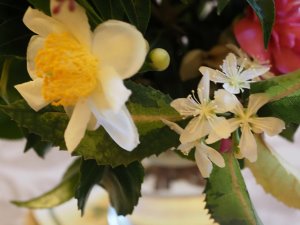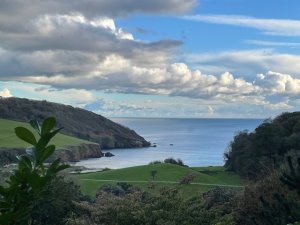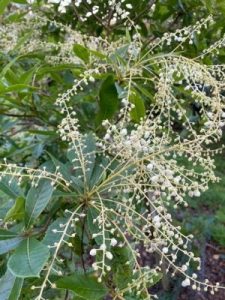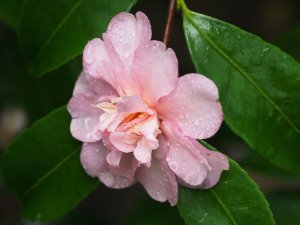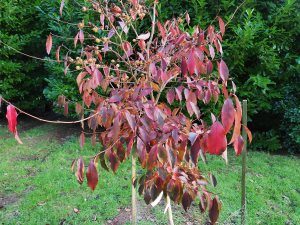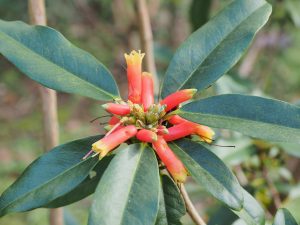2024 – CHW
Camellia x williamsii ‘J.C. Williams’ has a few flowers too high up on the original plants in the Aucklandii Garden to photograph. Nothing yet on any Camellia saluenensis.
Camellia sasanqua ‘Plantation Pink’. A small tight bud but opening nice and flat.


Proper first flowers now out on Rhododendron nobleanum. I saw the same on the Tregothnan drive yesterday.
Tin Garden cut yet again.
2021 – CHW
Camellia sasanqua (white) and Camellia sasanqua (pink) full out together in the sun.
The first flowers we have ever seen here on Disanthus cercidifolius. Tiny and I had thought to expect these in the spring. Very similar to Disanthus ovatifolius (previously Uocodendron whartonii) which proves this name change makes sense. What else has flowers shaped like these? Asimina triloba perhaps?
The colours on the Disanthus cercidifolius have developed well over the last fortnight. This is a very special autumn colour plant.
2020 – CHW
In the clump at the bottom of the Auklandii Garden three of the US Ackerman hardy hybrids are out but another four varieties are not yet. I may be wrong as ‘Snow Flurry’ and ‘Winter’s Snowman’ are very similar and both could be out.
Camellia ‘Winters Joy’ (Camellia sasanqua x Camellia oleifera) just coming out.
This is attached for comparison. Our plant’s flowers tend to droop downwards and are hard to see. Then we look at the similar Camellia confusa in the same book and it still is not quite the same as this but our supposed C. oleifera is closer to C. confusa than to C. oleifera. Undoubtedly our original plant is a Wilson or Forrest original. It self-seeds itself in several places around the garden.
The very first flowers this year on Camellia x williamsii ‘St Ewe’ in the Auklandii Garden.Another set of rather younger Stewartia than the ones which we viewed a few days ago in Kennel Close with autumn colour and some seeds. These are in the new Styrax/Stewartia planting area beside the old Charlie Michaels Nursery bed.This is labelled Stewartia sinensis. Good autumn colour but the seeds do not look quite right when I look at the ripe ones with five segments. However when I look at the ones still greenish-yellow and much more rounded they do look like the seed heads in Koen Camelbeke’s article dated 16.10.11.
Cotoneaster dammeri ‘Hybridus Pendulus’ growing well in a garden on the estate and looking superb today. Hilliers say it is a hybrid between C. dammeri with either Cotoneaster frigidus or Cotoneaster salisifolius. The berries are slightly red with a bit of yellow but perhaps not yet fully ripe.

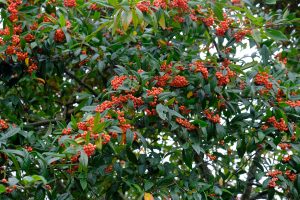
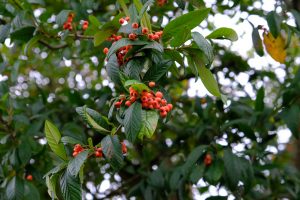
A good crop of seeds to gather on Styrax ‘Emerald Pagoda’. Large flowers and equally large seeds on this superb plant. No other styrax anywhere near.
Nyssa sylvatica ‘Wisley Bonfire’ on Burns Bank is superb in the sun. This is a new entry in the 2017 Burncoose catalogue and will be a certain hit.
2015 – CHW
Progress has still been slow in developing the autumn colour on the four liquidambers:
Liquidamber styraciflua ‘Oconee’ has just a few hints.
1955 – CW
November Pink well out. Even saw some flowers on Camellia noblissima. Very early year. Mucronulatum full out as is Yellow Hammer. Received Sasanquas from Edinburgh.
1945 – CW
Camellias sasanqua and oleifera out, also a couple of flowers of hybrid in big quarry. One Saluenensis in the way of a Pink (dark) form above Crino hedge fit to pick, just opening. A lot of daffs up. Some fuchsias and lapagerias. One Mag delavayi open and a bud on Michelia by Engine House, and Engine House double white camellia.
1940 – CW
A few Mag grandiflora left – no others but buds on Delavayi. There has been a little frost but fuchsias not hurt. A lot of rain in the last weeks. Some daffs coming up. Camellia sasanqua good. One flower of Camellia oleifera out on wall for some days. Rho davidsonianum hedge much flower east end enough for a big lot in hall.
1926 – JCW
C sasanqua are and have been nice. Lapagerias good. The first Iris stylosa a week ago. The worst year for medium and early rhodo’s, as bad I ever saw. Later sorts are good.
1912 – JCW
Just as above but Primula malacoeides replaces Iris alata.
1908 – JCW
Lapagerias fair. C sasanqua fair. Roses nice. No frost yet. Cyclamen over. Solanum good. I alata and stylosa nice.




















